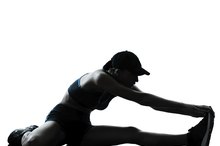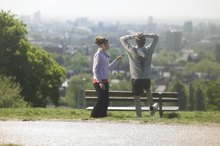How To Stretch the Gastrocnemius & Soleus Muscles
The soleus and gastrocnemius are two of the muscles in your calves and are heavily involved in many of the exercises you perform each day. An adequate fitness program will incorporate stretching because it increases flexibility, improves circulation and range of motion, and reduces muscle stress. Calf stretches also are incorporated into a rehabilitation program after an injury. The exercises to stretch the soleus and gastrocnemius are quite similar, and because both muscles are in the calf, they often will be stretched in tandem with one another.
Soleus Stretch
Stand facing a wall and place your hands flat on the wall at about chest height.
Stretching Exercises for ACL Injuries
Learn More
Place one leg slightly behind the other, with both your knees bent slightly. If you are doing the stretch as part of your rehab from an injury, place your injured leg in the back for the stretches.
Lean toward the wall gently until you begin to feel your calf stretch in the injured leg. Your heel should remain on the floor during the stretch and should not be elevated.
Stretches to Help Popliteus Tendinitis
Learn More
Stop leaning at the point at which you begin to feel the stretch, then hold the position for 30 seconds.
Return to a standing position, then repeat the stretch three more times.
Repeat the soleus stretches with the other leg, performing the stretch a total of four times.
- Stand facing a wall and place your hands flat on the wall at about chest height.
- Lean toward the wall gently until you begin to feel your calf stretch in the injured leg.
Gastrocnemius Stretch
Stand with your legs shoulder-width apart, about 2 feet to 3 feet from a wall. When standing, your hands should be able to reach the wall in front of you.
Extend your arms and hands and firmly plant your palms on the wall in front of you.
Lean against the wall.
Take one step forward with one foot, firmly planting your foot on the ground and bending your leg at the knee. During this, the heel of your back foot should be firmly planted and your toes should be pointed toward the wall.
Hold the position for six seconds, then relax for five seconds. The exercise should be performed two times on each leg, alternating between legs.
Tips
Warm up before stretching. Cold muscles are more likely to be injured from stretching, so it's best to do five or 10 minutes of low-intensity exercise before you stretch.
Do not hold your breath when you stretch. Instead, breathe freely and deeply.
Warnings
After an injury, speak with your doctor before beginning any exercise routine to prevent further exacerbation of your injury.
- Stand with your legs shoulder-width apart, about 2 feet to 3 feet from a wall.
- During this, the heel of your back foot should be firmly planted and your toes should be pointed toward the wall.
Related Articles
References
- North Dakota State University: Stretching Toward Better Health
- Green B, Pizzari T. Calf muscle strain injuries in sport: a systematic review of risk factors for injury. Br J Sports Med. 2017;51(16):1189-1194. doi:10.1136/bjsports-2016-097177
- Fleckenstein J, Wilke J, Vogt L, Banzer W. Preventive and Regenerative Foam Rolling are Equally Effective in Reducing Fatigue-Related Impairments of Muscle Function following Exercise. J Sports Sci Med. 2017;16(4):474-479.
Writer Bio
Anna Aronson began working as a journalist in 2000 and spent six years at suburban Chicago newspapers before pursuing freelance work. She enjoys writing about health care topics, in particular obstetrics, pediatrics and nutrition. She received a Bachelor of Arts in journalism from Eastern Illinois University and is now studying for a Master of Science in medicine degree to become a physician's assistant.








